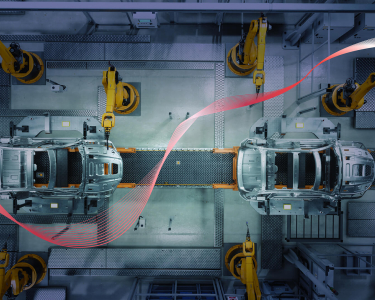Sustainability in Cloud: How Enterprises Are Reducing Carbon Footprints
The Green Imperative: Why Cloud Sustainability Matters
Every email sent, file stored, or AI query executed consumes energy. Multiply that by millions of businesses, and cloud computing’s energy footprint appears staggering. Data centers, the backbone of cloud infrastructure, use 1-1.5% of global electricity. By 2027, power demand within data centers is projected to reach 84 GW, with 27% for AI, 50% for cloud, and 23% for traditional workloads.
Without intervention, this footprint will only escalate. However, enterprises can cut emissions by up to 80% by migrating to public cloud infrastructure. Yet sustainability is not just about shifting workloads, it also requires strategic optimization, responsible energy use, and carbon footprint tracking.
Governments are enforcing stricter regulations: The EU’s Corporate Sustainability Reporting Directive (CSRD) mandates that over 50,000 companies disclose sustainability data, impacting investor confidence and compliance. Similarly, the SEC’s climate disclosure rules are pushing U.S. businesses toward emissions transparency.
To meet these expectations and remain environmentally conscious, leading cloud providers are investing in decarbonization.
Cloud Providers Leading the Way
Hyperscalers are investing in sustainability-focused innovations:
- Google Cloud: Targeting 100% carbon-free energy by 2030.
- Microsoft: Aiming to be carbon-negative by 2030, removing all historical emissions by 2050.
- AWS: Committed to 100% renewable energy by 2025.
They are also deploying advanced technologies to reduce cloud energy consumption:
- Liquid cooling and AI-based load balancing for 40% improved energy efficiency in cloud facilities.
- Custom energy-efficient processors for optimized workloads, reducing power wastage.
- Submerged data centers (e.g., Microsoft’s Natick Project) to eliminate air cooling needs, significantly cutting energy consumption.
While cloud providers lay the foundation, enterprises must optimize their cloud usage to achieve meaningful sustainability gains.
How Enterprises Can Reduce Cloud Carbon Footprints
Sustainability is not just about where workloads run, but how efficiently they operate. Here’s how enterprises can cut cloud emissions:
- Cloud Optimization and FinOps: Rightsizing workloads, leveraging serverless architectures, and auto-scaling prevent overprovisioning.
- Green Software Engineering: Optimized algorithms, fewer API calls, and data compression lower cloud energy use.
- Hybrid and Multi-Cloud Approaches: Solutions like Hybrid BlazeTech allow businesses to run workloads in energy-efficient cloud regions, reducing reliance on high-carbon data centers. Edge computing reduces latency and energy demand by processing data closer to users.
- Optimize Data Storage: Tiered storage minimizes energy-intensive high-performance storage for rarely accessed data.
- Extend Hardware Lifecycles: Server virtualization and workload optimization (CBT-Intel Optimization scripts and Kubernetes Pod-level cost management) reduce e-waste and infrastructure turnover.
Beyond technology, adopting a circular economy approach further enhances sustainability.
Circular Economy in Cloud Computing
A circular economy model shifts the focus from a traditional "take-make-dispose" approach to a more sustainable "reduce-reuse-recycle" framework. In cloud computing, this involves:
- Reusing and Refurbishing IT Hardware: Instead of discarding outdated servers, companies are refurbishing and repurposing them for secondary workloads.
- Sustainable Supply Chains: Sustainable IT asset disposal programs ensure responsible recycling of outdated hardware. Cloud providers are recovering rare earth metals from decommissioned data centers to reduce mining-related environmental impact.
- E-waste Management: Services like Microsoft’s Asset Recovery Service ensure that outdated hardware is responsibly disposed of or recycled.
- Energy Capture and Heat Reuse: Data centers produce vast amounts of heat, which can be redirected for district heating systems, greenhouse farming, or industrial processes. For example, in Denmark, Microsoft's data centers provide heat to 6,000 homes, highlighting the potential of energy recapture.
AI and Automation for Sustainability
AI-driven optimizations are making cloud computing more sustainable through:
- AI-driven Predictive Analytics: Enterprises can anticipate peak demand periods and dynamically adjust computing resources, reducing energy use.
- Automated Workload Scheduling: Tasks run during renewable energy availability, cutting carbon impact. AI identifies underutilized resources and redistributes workloads to cloud regions with lower carbon footprints.
- Smart Resource Allocation: AI optimizes CPU and GPU utilization, ensuring that idle computing power is not wasted. For instance, Hybrid BlazeTech’s dynamic scaling prevents idle energy consumption.
Measuring and Reporting Carbon Footprints in the Cloud
Enterprises are leveraging real-time emissions tracking to ensure accountability:
- AWS Carbon Footprint Tool & Azure Sustainability Calculator for real-time emissions tracking.
- Tracking Scope 1, 2, and 3 emissions helps quantify direct, indirect, and supply chain-related emissions.
- Sustainability dashboards help set and monitor reduction targets.
Tech Mahindra’s Leadership in Sustainable Cloud
Tech Mahindra is a recognized leader in green cloud solutions and was featured in TIME Magazine and Statista’s World’s Most Sustainable Companies 2024.
Ranked #1 in India and #2 globally in S&P Dow Jones Sustainability Indices 2024 (TSV IT), the company aims to be Net Zero by 2035, with carbon neutrality and 90% renewable energy by 2030, and water positivity and zero landfill waste across facilities.
At the 2023 BT Sustainability Festival, Tech Mahindra’s Chief Sustainability Officer Sandeep Chandna outlined our commitment to sustainable digital infrastructure. To drive this, the company is certifying engineers in eco-design and green IT by FY 2025-26 and has launched training sessions on green data coding.
Unlike cloud providers that focus solely on infrastructure decarbonization, Tech Mahindra helps businesses actively reduce cloud-related emissions through:
- Green Data Centres and Server Virtualization – Cutting Scope 2 emissions, reducing Capex by 15% over 3 years, and improving productivity by 10% YoY. Tech Mahindra’s GreenOps Framework balances cost, performance, and sustainability for optimized cloud efficiency. Tech Mahindra’s multi-pronged approach leverages IoT and AI to efficiently monitor and track energy and water usage by monitoring critical Green data centre KPIs. Our comprehensive solution package brings DC level under Centralized Platform to optimize resource utilization. Our partner led solutions help clients in achieving energy savings both in data centre white space and grey space by optimally managing energy conservation on cooling and server side respectively. These solutions will provide the energy savings up to 25% to 40% bringing 100% thermal compliance and reducing cooling power up to 15% on an average. With proven use cases across telecom, digital infrastructure, data centre providers where the customers have realized the benefits from deploying the same.
- Cloud Service Management – Accounts for 74.06% of its green revenue through energy-efficient operations. Through eco-friendly cloud migration, Tech Mahindra shifts businesses to green cloud architectures with minimal carbon impact.
- Hybrid BlazeTech – Developed with Intel, this AI-driven workload optimization framework reduces TCO by 45%, speeds time-to-market by 30%, and reduces costs by 55%.
- Real-time Carbon Footprint Monitoring – At Tech Mahindra, we believe sustainability and smart cloud management go hand in hand. That’s why we take a practical, data-driven approach to help businesses cut down on cloud emissions and reduce costs. Our Green Cloud Carbon Footprint (GCCF) utility is at the centre of this, offering real-time insights into your cloud’s carbon footprint across providers and workloads. It looks at how your resources are being used, translates that into both emissions and cost impact and shows you exactly where improvements can be made. With easy-to-read dashboards and actionable recommendations, GCCF helps you spot high-emission, high-cost areas so you can make smarter, greener decisions. It’s how we help you build a cloud environment that’s not just efficient, but sustainable too.
- Pay-Per-Use Models – Reduces unnecessary hardware investments and emissions by shifting costs from Capex to Opex.
- i.Sustain - Powered by SAP and Tech Mahindra’s expertise, offers end-to-end sustainability solutions with automated data management and governance.
Through these initiatives, Tech Mahindra is helping enterprises cut costs, lower emissions, and meet sustainability goals - driving a greener, more responsible cloud ecosystem.
Industry Use Cases and Success Stories
Tech Mahindra is already helping enterprises achieve cloud sustainability:
- Manufacturing:
- Implementing green ledger-based carbon accounting, enabling manufacturers to track emissions, optimize supply chains, and meet net-zero goals.
- Designing a green manufacturing facility for a Europe-based zero-carbon battery manufacturer.
- BFSI: Helps BFSI institutions achieve sustainability with ESG solutions, strategic partnerships, and data-driven insights for compliance and growth. Provides end-to-end services, from audits to digital platforms, for seamless ESG integration.
- Maintenance Products: A global provider of industrial, commercial, and institutional maintenance products and services, faced high energy consumption due to outdated OS versions and inefficient resource management. Tech Mahindra addressed these issues, recommending energy-efficient hardware and implementing optimizations that resulted in an 11.32% reduction in energy consumption and a corresponding decrease in CO2 emissions.
- Pharma: A large European pharmaceutical company collaborated with Tech Mahindra to conduct a comprehensive ESG data assessment. This included data collection, analysis, integration, and custom dashboard development for specific needs such as emission monitoring, community investments, and compliance. Tech Mahindra mapped ESG KPIs to the source data, identified relevant metrics from the provided raw data, and automated data collection using connectors and APIs. This streamlined approach to data collection, entry, monitoring, management, and reporting delivered valuable insights.
- Private Equity: Tech Mahindra offers digital ESG solutions for Private Equity, including dashboards for real-time tracking and AI-powered analytics for informed decisions. This helps PE firms manage ESG risks, improve portfolio company efficiency, and satisfy investor sustainability demands. Tech Mahindra’s expertise covers the entire investment process, embedding ESG from start to finish and ultimately enabling PE firms to create value through responsible investing.
- Mobility and Spatial: Tech Mahindra facilitated the adoption of green IT principles for a major Australian mobile and spatial technology solutions company. This included tracking carbon emissions in source code and training development teams in green coding practices, which significantly highlighted their green impact and areas needing improvement. To reduce their carbon footprint, Tech Mahindra:
- Upgraded operating systems to boost power efficiency by 10-15%.
- Replaced outdated hardware, achieving energy savings of up to 25%.
- Reduced virtual machines by 20% for further energy conservation.
- Categorized data into Hot, Cold, and Archive databases, resulting in a 15% energy saving.
- Telecom:
- Migrated Telia’s monolithic Customer Information Management (CIM) platform to a cloud-native AWS microservices architecture; reducing carbon footprint, improving performance, and cutting hardware dependency.
- A major French telecom provider partnered with Tech Mahindra to leverage tool-based Green IT index calculations on their customer software. This enabled the precise measurement of energy consumption and identified opportunities for significant energy savings, thereby reducing the carbon footprint. Key outcomes included:
- Green IT index helped demonstrate energy savings of up to 30%
- Revisited coding best practices to educate developers and architects.
The Future of Green Cloud Computing
With data center energy demand projected to triple by 2030, the push for greener cloud solutions is accelerating. Emerging innovations are set to transform cloud sustainability:
- Quantum Computing – Could slash energy consumption by solving complex problems with fewer resources.
- Next-Gen Data Centers – Hydrogen fuel cells, geothermal cooling, and AI-powered energy management could cut power usage by 40%.
- Policy and Collaboration – Stricter emissions regulations and industry partnerships are making sustainability a business priority, not just an option.
Conclusion
Morgan Stanley claims that the global data center industry is projected to emit approximately 2.5 billion metric tons of CO₂ through 2030, driven by the expansion of AI and cloud computing technologies. To address this, enterprises are increasingly adopting metrics like Power Usage Effectiveness (PUE) and Carbon Usage Effectiveness (CUE) to monitor and reduce their data centers' carbon footprints. Initiatives such as the Climate Neutral Data Centre Pact aim for climate neutrality by 2030, emphasizing energy efficiency, renewable energy usage, and carbon reduction strategies.
Enterprises failing to adopt green cloud strategies will risk regulatory penalties, higher operational costs, and reputational damage. However, the path to sustainability remains clear. By optimizing cloud usage, embracing circular economy principles, and leveraging cutting-edge technologies, businesses can cut emissions, reduce costs, and gain a competitive edge.
Tech Mahindra’s sustainable cloud solutions provide enterprises with the necessary expertise and tools to shift towards a low-carbon future-ready infrastructure, where profitability and sustainability go hand in hand.
Endnotes
- IEA. (n.d). Data Centres and Data Transmission Networks. IEA.com
- Lexology. (n.d). Artificial Intelligence and Data Centers Predicted to Drive Record High Energy Demand. Lexology.com
- Ministry of Foreign Affairs of Denmark. (Mar 2024). Microsoft data centre set to provide surplus heating for 6.000 Danish homes. investindk.com
- BT Sustainability Festival. (n.d). Green IT - exploring the role of technology in sustainability. atadastral.co.uk
- Goldman Sachs (May 2024). AI is poised to drive 160% increase in data center power demand. Goldmansachs.com
- Reuters. (Sep 2024). Global data center industry to emit 2.5 billion tons of CO2 through 2030, Morgan Stanley says. reuters.com
Sudhir Gopalaiah is a seasoned Practice and Solutions Head for Cloud Infrastructure Services at Tech Mahindra, with over 27 years of experience in the IT industry. In his role, Sudhir combines strategic vision with deep technical expertise to lead cloud infrastructure initiatives that align with business objectives and drive innovation.
Read MoreSudhir Gopalaiah is a seasoned Practice and Solutions Head for Cloud Infrastructure Services at Tech Mahindra, with over 27 years of experience in the IT industry. In his role, Sudhir combines strategic vision with deep technical expertise to lead cloud infrastructure initiatives that align with business objectives and drive innovation.
Sudhir spearheads solutioning for customer requirements and plays a pivotal role in presales / solutions activities. He leads a dedicated team in developing platforms and Solution Accelerators, enhancing the company's solution offerings. With specialties in presales, solutioning, architecting, and tool automation, Sudhir ensures the delivery of scalable, secure cloud solutions that provide exceptional value to clients.
His leadership extends to managing cloud infrastructure strategy, optimizing costs, ensuring security and compliance, and building strong vendor relationships. Sudhir is committed to fostering a culture of excellence and operational efficiency, positioning Tech Mahindra as a leader in cloud services.
Read Less







